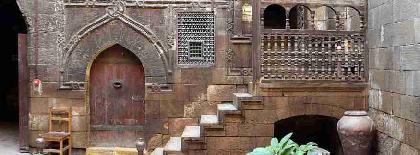 The Museum of Gayer Anderson or the Bait of El-Kritliya lies in El Sayyida Zaynab Square nearby the mosque of Ibn Tulun. The monument consists of two houses: the one on the right that was constructed by Abd El-Qader El-Haddad was used as a Haramlik, while the other house that belongs to Amna the daughter of Salem El-Gazzar was used as a Salamlik. The complex was inhabited by the family of El-Kiridly family in 1834 and this is the reason for giving the house that name. The building was restored by a British officer in the Egyptian Army called Gayer Anderson who inhabited it from 1935 to 1942. It exists now as a well preserved and richly decorated and furnished museum that dates back to the Ottoman period.
The Museum of Gayer Anderson or the Bait of El-Kritliya lies in El Sayyida Zaynab Square nearby the mosque of Ibn Tulun. The monument consists of two houses: the one on the right that was constructed by Abd El-Qader El-Haddad was used as a Haramlik, while the other house that belongs to Amna the daughter of Salem El-Gazzar was used as a Salamlik. The complex was inhabited by the family of El-Kiridly family in 1834 and this is the reason for giving the house that name. The building was restored by a British officer in the Egyptian Army called Gayer Anderson who inhabited it from 1935 to 1942. It exists now as a well preserved and richly decorated and furnished museum that dates back to the Ottoman period.
The entrance of the house is through the Southern gate of the mosque of Ibn Tulun. The house is gracefully designed from inside and divided into luxuriously furnished rooms. Most of the furniture of the house traces back to the 16th or 17th century, but there some objects from other periods. There are also some marvelous pieces of furniture from Iran and Syria. The Museum is worth seeing for the beautiful Haramlik that appears on the right side of the complex. The lower story of the Haramlik consists of a wide Qaa which can be regarded as a good example for the rooms that were found in the 16th century. Then one can find the Maqaad or the setting room and some other small rooms in the upper floor.
There is also a Qaa that is supplied with a handsome fountain, beautifully decorated ceiling, and gracefully ornamented Mashrabiya windows and other wooden works that highlights the beauty of Ottoman style of decoration. The building was restored by adding the Damascus room with its 17th century Syrian style. The walls and ceiling of the room are painted in intricate gold and lacquer patterns. Of special interest in this house are, in addition to its beauty that appears in the vestiges and objects that are placed in it, interesting stories and local legends that are narrated about it and about the spirits of its owner who still live in it.
